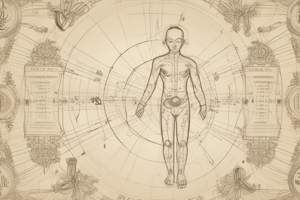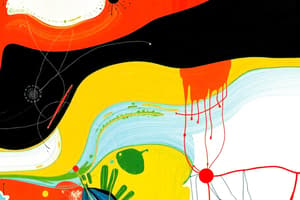Podcast
Questions and Answers
How does the 'Alternative Uses Task' operationalize the construct of creativity, and what are its key limitations in capturing the multifaceted nature of creative thought?
How does the 'Alternative Uses Task' operationalize the construct of creativity, and what are its key limitations in capturing the multifaceted nature of creative thought?
- It assesses creativity by measuring the speed at which participants can generate alternative uses for common objects, focusing on cognitive flexibility and fluency but neglecting the originality of ideas.
- It quantifies creativity through the novelty and usefulness of ideas generated for a common object, utilizing a scoring system that emphasizes divergent thinking while overlooking convergent thinking abilities.
- It measures creativity by evaluating the total number of different categories a participant's ideas belong to, combined with an average creativity score assigned by raters, thereby integrating both divergent and convergent thinking. (correct)
- It emphasizes fluency, flexibility, originality, and elaboration in generating alternative uses for an object, providing a comprehensive measure of divergent thinking that effectively captures the essence of creativity.
Which statement accurately reflects the modern understanding of the neural basis of creativity, moving beyond the oversimplified notion of hemispheric dominance?
Which statement accurately reflects the modern understanding of the neural basis of creativity, moving beyond the oversimplified notion of hemispheric dominance?
- Creative tasks activate diverse regions across both hemispheres, emphasizing the integrated function of multiple brain networks rather than the sole dominance of either hemisphere. (correct)
- Creativity is primarily localized in the right hemisphere, where intuitive and non-linear thinking processes dominate, inhibiting the need to actively engage analytical left-hemisphere functions.
- Creativity is associated with increased activity in specific areas of the left hemisphere, where cognitive control oversees the generation and evaluation of novel ideas.
- The creative process relies on the synchronization of both hemispheres, yet the left hemisphere's role in language and logic often suppresses the generation of novel ideas.
In the context of the temporal dynamics of the creative process, how does the stage of 'incubation' uniquely contribute to creative problem-solving?
In the context of the temporal dynamics of the creative process, how does the stage of 'incubation' uniquely contribute to creative problem-solving?
- Incubation involves actively engaging with a task, focusing conscious attention to gather necessary information for idea generation.
- Incubation is characterized by the sudden emergence of a creative idea into conscious awareness, often referred to as the 'aha' moment.
- Incubation serves as the phase in which creative ideas are refined and practically applied through rigorous evaluation and testing.
- Incubation allows for subconscious processing as conscious attention is diverted away from the task, fostering novel connections and insights. (correct)
Considering the Default Mode Network (DMN) and Cognitive Control Network (CCN), how do these interconnected brain networks interplay during creative thought?
Considering the Default Mode Network (DMN) and Cognitive Control Network (CCN), how do these interconnected brain networks interplay during creative thought?
How does mind-wandering, as a spontaneous cognitive process, influence the incubation stage of creativity, and what neural mechanisms underpin this phenomenon?
How does mind-wandering, as a spontaneous cognitive process, influence the incubation stage of creativity, and what neural mechanisms underpin this phenomenon?
What implications does the finding that episodic memory, imagination, and creative thinking all activate the bilateral hippocampus have for understanding the cognitive architecture of creativity?
What implications does the finding that episodic memory, imagination, and creative thinking all activate the bilateral hippocampus have for understanding the cognitive architecture of creativity?
How do individual differences in personality, particularly openness to experience, interact with cognitive processes to influence creative potential?
How do individual differences in personality, particularly openness to experience, interact with cognitive processes to influence creative potential?
Considering the research on microdosing with psilocybin, what caveats must be considered when interpreting claims about enhanced creativity and well-being?
Considering the research on microdosing with psilocybin, what caveats must be considered when interpreting claims about enhanced creativity and well-being?
In the context of cultural evolution and technological advancement, what crucial distinction differentiates a 'cognitive niche' from a 'cultural niche'?
In the context of cultural evolution and technological advancement, what crucial distinction differentiates a 'cognitive niche' from a 'cultural niche'?
How does the 'REBUS' (Relaxed Beliefs Under pSilocybin) model explain the reported effects of psilocybin on creativity in terms of cognitive and neural processes?
How does the 'REBUS' (Relaxed Beliefs Under pSilocybin) model explain the reported effects of psilocybin on creativity in terms of cognitive and neural processes?
Considering the study involving the construction of devices with rotating wheels, how did inheriting a pre-existing theory, versus developing one independently, influence participants' creative problem-solving?
Considering the study involving the construction of devices with rotating wheels, how did inheriting a pre-existing theory, versus developing one independently, influence participants' creative problem-solving?
Which EEG band is associated with complex problem solving?
Which EEG band is associated with complex problem solving?
Which of the following does not contribute to creativity?
Which of the following does not contribute to creativity?
What is the relation between sleep and brain activity?
What is the relation between sleep and brain activity?
In the temporal dynamics of the creative process, what is evaluated in the verification stage?
In the temporal dynamics of the creative process, what is evaluated in the verification stage?
Which measure of 'Operationalizing the Construct' refers to a coding system for human raters?
Which measure of 'Operationalizing the Construct' refers to a coding system for human raters?
In the measures, how is the average uniqueness score calculated?
In the measures, how is the average uniqueness score calculated?
What is cognitive flexibility?
What is cognitive flexibility?
Which scientific paper is credited with the four stages of the creative process known as Preparation, Incubation, Illumination, and Verification?
Which scientific paper is credited with the four stages of the creative process known as Preparation, Incubation, Illumination, and Verification?
What statement best describes the function of the anterior insular cortex (AIC) within the Cognitive Control Network (CCN) regarding creativity?
What statement best describes the function of the anterior insular cortex (AIC) within the Cognitive Control Network (CCN) regarding creativity?
When considering the influence of sleep on the neural basis of creativity, its role is thought to be particularly involved in what?
When considering the influence of sleep on the neural basis of creativity, its role is thought to be particularly involved in what?
How does the concept of 'neural reuse' pertain to the neural basis of creativity?
How does the concept of 'neural reuse' pertain to the neural basis of creativity?
According to Sawyer in 2011, it is a myth that one side of the brain is more creative than the other. Which statement is correct about brain activity and creativity?
According to Sawyer in 2011, it is a myth that one side of the brain is more creative than the other. Which statement is correct about brain activity and creativity?
Aside from IQ, what is another factor related to individual differences in creativity?
Aside from IQ, what is another factor related to individual differences in creativity?
Considering the experiment that shows that causal understanding is not necessary for the improvement of culturally evolving technology, what is not true?
Considering the experiment that shows that causal understanding is not necessary for the improvement of culturally evolving technology, what is not true?
Flashcards
The Construct
The Construct
A set of covarying observed behaviors.
Creativity
Creativity
The process of bringing into being something that is both new and useful.
Preparation (creative process)
Preparation (creative process)
Acquisition of knowledge to some task.
Incubation (creative process)
Incubation (creative process)
Signup and view all the flashcards
Illumination (creative process)
Illumination (creative process)
Signup and view all the flashcards
Verification (creative process)
Verification (creative process)
Signup and view all the flashcards
Alternative Uses Task
Alternative Uses Task
Signup and view all the flashcards
Cognitive Flexibility
Cognitive Flexibility
Signup and view all the flashcards
Average Uniqueness Score
Average Uniqueness Score
Signup and view all the flashcards
Average Creativity Score
Average Creativity Score
Signup and view all the flashcards
Left and Right Brain Myth
Left and Right Brain Myth
Signup and view all the flashcards
Mind-wandering
Mind-wandering
Signup and view all the flashcards
Default Mode Network (DMN)
Default Mode Network (DMN)
Signup and view all the flashcards
Cognitive Control Network (CCN)
Cognitive Control Network (CCN)
Signup and view all the flashcards
Task-negative (DMN) regions
Task-negative (DMN) regions
Signup and view all the flashcards
Task-positive (CCN) regions
Task-positive (CCN) regions
Signup and view all the flashcards
Delta brainwaves
Delta brainwaves
Signup and view all the flashcards
Theta brainwaves
Theta brainwaves
Signup and view all the flashcards
Alpha brainwaves
Alpha brainwaves
Signup and view all the flashcards
Beta brainwaves
Beta brainwaves
Signup and view all the flashcards
Gamma brainwaves
Gamma brainwaves
Signup and view all the flashcards
Cognitive Niche vs Cultural Niche
Cognitive Niche vs Cultural Niche
Signup and view all the flashcards
Microdosing with psilocybin mushrooms
Microdosing with psilocybin mushrooms
Signup and view all the flashcards
REBUS model
REBUS model
Signup and view all the flashcards
Study Notes
Defining and Operationalizing Creativity
- Creativity explains covarying observed behaviors.
- It is defined as the process of bringing something new and useful into being.
- Wallas described the temporal dynamics of the creative process as preparation, incubation, illumination, and verification.
Operationalizing the Construct
- The Alternative Uses Task from Guilford in 1967 involves asking "What can you do with a brick?" and gives participants a 2-minute response time.
- Measures for this task include coding schemes for human raters, cognitive flexibility, average uniqueness score, and creativity score.
- Cognitive Flexibility involves counting the different categories a participant's ideas belong to.
- Average uniqueness score is calculated by dividing the frequency by how often a specific idea is mentioned among all participants by the total number of named ideas.
- Average creativity score involves two raters scoring the creativity of each idea on a five-point scale from "not at all creative" to "extremely creative".
Neural Basis of Creativity
- The belief that the left and right brains are responsible for creativity is a myth.
- Many regions of the brain in both hemispheres are active during creative tasks.
- Incubation has positive effects on creativity.
- Mind-wandering is a state that occurs spontaneously when an awake individual is not engaged in a demanding task.
- Default Mode Network (DMN) Includes the medial prefrontal cortex (MPFC), posterior cingulate cortex (PCC), lateral and medial temporal lobes.
- Cognitive Control Network (CCN) includes the anterior cingulate cortex (ACC), dorsolateral prefrontal cortex (DLPFC), inferior frontal junction (IFJ), anterior insular cortex (AIC), dorsal pre-motor cortex (dPMC), and posterior parietal cortex (PPC).
- Research suggests that episodic memory, imagination, and creative thinking activate the bilateral hippocampus.
- The same brain region that supports memory also supports imagination and creation.
Individual Differences and Interventions
- ID Factors include IQ and Personality.
- Explanatory Power is at 32.6% of variance.
- In a double-blind placebo-controlled study with psilocybin mushrooms (N = 34) subjective experience, behavior, creativity, perception, cognition, and brain activity were measured.
- Some participants reported acute effects of active psilocybin; only participants who correctly identified their experimental condition however.
- Psilocybin can effect the Default Mode Network.
- Psilocybin interventions have mixed results.
Cultural Evolution
- Cognitive vs Cultural Niche: Intelligence vs gradual accretion of knowledge.
- Causal understanding is not necessary for the improvement of culturally evolving technology.
- Participants who did not inherit any theory generated a greater range of wheels than those who did.
- Inheriting one theory increased understanding of it, but reduced understanding of the other.
- Performance in a 2-D problem was neutral.
- For >D problems, better understanding of one dimension is unlikely to compensate for worse understanding of all of the others.
Studying That Suits You
Use AI to generate personalized quizzes and flashcards to suit your learning preferences.



